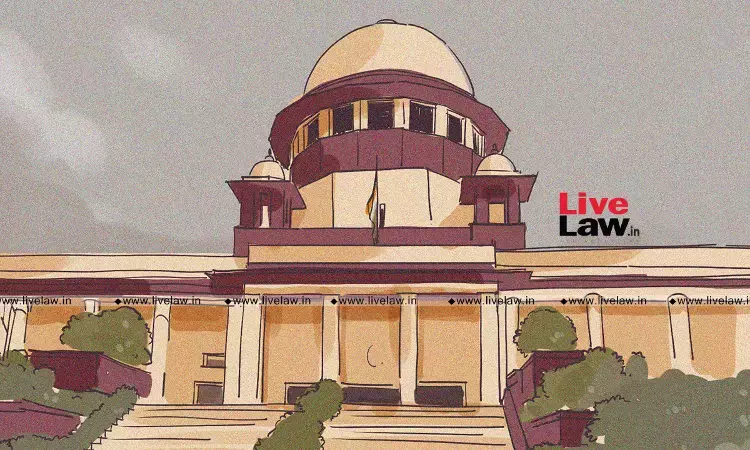- Home
- /
- Supreme court
- /
- Supreme Court Reiterates Principles...
Supreme Court Reiterates Principles Of Deduction For Development Charges In Land Acquisition Compensation Claims
LIVELAW NEWS NETWORK
18 Aug 2023 8:19 PM IST
A Division Bench of the Supreme Court, comprising Justices Bela M. Trivedi and Dipankar Datta, while hearing a bunch of appeals reiterated the established law that while determining the deduction for development charges, the courts should take into consideration important factors including the nature of land, area under acquisition, whether the land is developed or not, if developed to...
A Division Bench of the Supreme Court, comprising Justices Bela M. Trivedi and Dipankar Datta, while hearing a bunch of appeals reiterated the established law that while determining the deduction for development charges, the courts should take into consideration important factors including the nature of land, area under acquisition, whether the land is developed or not, if developed to what extent, the purpose of acquisition etc. This exercise is required for ascertaining the percentage of deduction by the Courts.
Case Background
The Hoshiarpur Improvement Trust (Respondent No.3) prepared a scheme for the purpose of Development Scheme (residential) under Sections 24, 25 and 28 of the Punjab Town Improvement Act, 1922 in an area admeasuring 291 kanals 7 marlas situated within the Municipal limits in village Purhiran and Sutehri. Out of the said land, 230 kanals 9 marlas belonged to the Municipal Committee, Hoshiarpur, which were taken over by the Land Acquisition Collector (Improvement Trust) (Respondent No.2), through negotiations. To acquire the rest of the lands admeasuring 59 kanals 3 marlas, a notification under Section 36 of the Improvement Act was issued on 29.07.1994.
These appeals have arisen out of the common judgment and order dated 17.08.2010 passed by the High Court of Punjab and Haryana at Chandigarh in Civil Writ Petition No.20433/2009 and others. Before the High Court, 14 writ petitions were filed by the land owners itself and 26 writ petitions were filed by the Improvement Trust, Hoshiarpur. The High Court allowed the writ petitions filed by the land owners by enhancing the market value of the acquired land to Rs.2,000/- per marla and granted all statutory benefits available under the Land Acquisition Act 1894 (Act). Further, the Court also dismissed the writ petitions filed by the Improvement Trust. The Land owners being dissatisfied by the said order filed this present appeal.
Contentions of the Parties
Senior Advocate Mr. P.S. Patwalia, appearing for the appellants, submitted that the lands in question were being used both for commercial and residential purposes and the High Court had erred in not relying upon the sale deeds executed for the shops prior to the date of acquisition, which showed continuous rise in the prices.
Further, the Counsel relied upon Haryana State Industrial Development Corporation vs. Pran Sukh and Others, (2010) 11 SCC 175, to contend that the High Court had committed gross error in applying one third cut on the assessed market value towards development charges.
On the other hand, Counsel, appearing for the respondent, submitted that when a large chunk of land is being acquired, a suitable deduction is required to be made towards the development charges as per the settled legal position, which has rightly been done by the High Court.
Court’s Observations
The Court noted that for ascertaining the market value of the land, its existing condition, location and user, its proximity to residential, commercial or industrial area etc. are the major factors required to be considered. However, the Court opined that the size and nature of the lands acquired and size and nature of the lands in respect of which sale instances are produced on record, also would be an important aspect because:
“in as much as normally the sale instances of small piece of land cannot form reasonable basis to determine the market value of large chunk of land, unless suitable deductions are made in respect of development charges.”
Based on this, Court agreed with the view taken by the High Court for relying upon only specific sale instances and not the ones pleaded by the appellants. It elucidated:
“The solitary sale instance of shop has rightly been ignored, the other sale instances more germane and relevant of the lands situated in nearby area of the area of acquisition being available on record.”
Lastly, the Court addressed another submission of the appellants pertaining to the one third cut imposed by the High Court. The Apex Court observed that it is only after determination of the market value of the lands and taking into consideration the settled legal position, the High Court has deducted one third amount therefrom towards the development charges. It recorded:
“The percentage of deduction or the extent of area required to be set apart has to be assessed by the courts having regard to the size, shape, situation, user etc. of the lands acquired. It is essentially a kind of guess work the courts are expected to undertake.”
To reason the said principle, Court relied upon catena of judgments including in Chimanlal Hargovinddas v. Special Land Acquisition Officer, (1988) 3 SCC 751 and Poona and Anr, Lal Chand v. Union of India and Anr (2009) 15 SCC 769.
In view of the same, the Court held that the High Court has rightly concluded that a cut of one third was required to be imposed on the amount of compensation awarded by it.
“When the impugned judgment of High Court reveals that the High Court has taken into consideration the relevant factors prescribed under the Act, as interpreted by this Court, the assessment of market value so determined does not warrant any interference of this Court in the appeals under Article 136 of the Constitution of India.”
Case title: MALA ETC. ETC v. STATE OF PUNJAB AND OTHERS, CIVIL APPEAL NOS. 3992-4000/2011
Citation : 2023 LiveLaw (SC) 663


